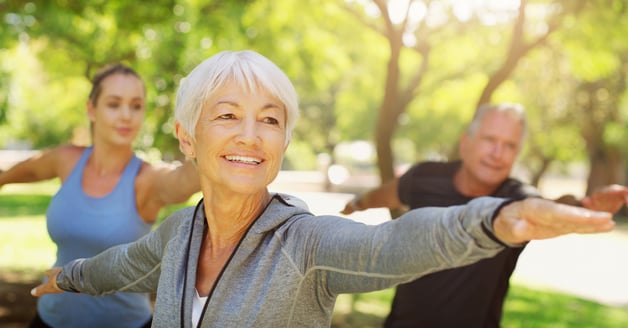
Yoga is a centuries-old practice that originated in northern India, but it has become incredibly popular across the United States and beyond in recent years. Yoga’s main appeal today is that it offers a challenging, low-impact workout that can be tailored to nearly any fitness level or schedule. And, it effectively combines physical exercise with controlled breathing and mindfulness exercises that help many people reduce stress and improve mental clarity as well.
Yoga really shines as a workout option for seniors because it’s so adaptable to individual abilities and energy. However, as with any exercise program, there are some risks of injury, especially if an older person begins a yoga practice without instruction, or if they try to do too much, too soon.
The following tips can help seniors get the most out of this highly beneficial exercise safely.
Seek out information and help
Beginning a walking program is pretty straightforward. While you’ll want to approach it reasonably, it doesn’t take a lot of instruction and training. On the other hand, with thousands of physical movements (called yoga poses or asana) to choose from — ranging from very simple, to incredibly complex and challenging — yoga is not the kind of exercise program anyone can simply jump into on his or her own.
As a yoga beginner, your best bet is to do plenty of research first or work with a qualified instructor. In fact, many people do both to get their practice off to a good start.
There are plenty of quality videos available for free on YouTube and yoga-specific sites that can provide instruction specifically for beginners, and most communities these days have at least one yoga studio where beginner classes are routinely held. You can also log onto an online discussion forum to ask specific questions from a large and knowledgeable community of experienced yogis (people who practice yoga).
Choose a yoga practice that’s appropriate for you
There are a dizzying array of yoga styles and trends you’ll likely come across in your research, and they are definitely not all for everyone. Beyond choosing a beginner’s course or class if you’re new to yoga, it’s also important to choose a style that’s most likely to be conducive to the limitations and abilities of older yogis.
Carol Krucoff is a yoga therapist who has been teaching the practice in medical settings for 20 years. She recommends, “to find a class designed for mature bodies, look for names such as ‘Yoga Over 50,’ ‘Gentle Yoga,’ or ‘Senior Yoga..”
Krucoff goes on to offer the following style-specific recommendations when it comes to choosing the best available options for seniors:
- “When a class is marketed as hatha yoga, it generally signifies a non-gimmicky approach to basic postures and breathing, which may be a good starting place.”
- “Viniyoga and Kripalu yoga are relatively gentle styles that may be appropriate for people with health concerns.”
- “Restorative yoga involves using supports (such as blankets and yoga blocks or bolsters) to prop students into passive poses that promote profound rest.”
- “If you have medical issues, get guidance about specific movement precautions. For example, people with glaucoma may be advised to avoid "head-down" positions, which may increase pressure in the eye.”
- “Hot yoga may be problematic for people with heart conditions because high temperatures can increase cardiac workload.”
Other good options for seniors to consider include:
- Chair Yoga- This is geared towards people who may not be able to stand for long periods of time or who are unable to do the exercises on a floor mat. Poses are modified using a chair for support.
- Water Yoga- Many of the same poses that are done on a mat are done in the water. Some seniors prefer this low-impact method because it can help with joint pain.
In all cases, discuss your desire to practice yoga with your doctor. Then, take those recommendations into consideration along with your own preferences and what options are available near you.
Start slow
As with any exercise program, it’s important to start slow and progress at a pace that’s appropriate for your own body.
Jessica Matthews, assistant professor of exercise science at Miramar College in San Diego explains, “one of the most important things is taking great care to understand what your body needs. If you have arthritis, limited mobility, or other health issues, there is a modification for almost every yoga pose to accommodate your physical needs.”
Most injuries sustained by seniors practicing yoga come not because a particular pose or stretch is inherently difficult or outside the individual’s potential, but instead the injuries occur when the individual pushes to master the pose too quickly without building the necessary strength, balance, and flexibility.
That’s why it’s vital to listen to your body, and err on the side of caution as your practice progresses. With patience and perseverance, you’ll get where you want to go, but rushing the process can lead to problems.
Enjoy the process
By choosing the right yoga style for you, learning how to do it safely and effectively, and taking your new practice slowly, you can enjoy a progressive yoga practice for years to come, without being overly concerned about injuries or other complications.
The best part of that success is that you can enjoy the mental, emotional, and physical benefits yoga brings, no matter how old you are. So, enjoy the process and the benefits it inevitably brings.

